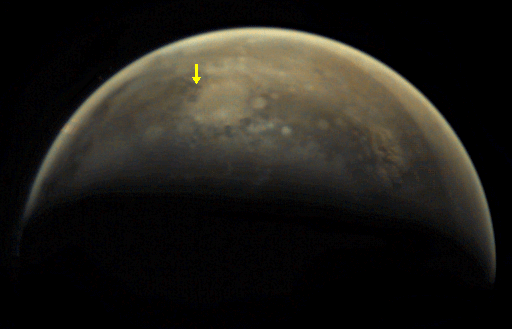Emily Lakdawalla • Feb 02, 2010
Mars Express animation of Phobos' shadow transiting Mars
A cool item was posted to the Mars Express VMC website this morning:
For the first-time ever, VMC has imaged what we believe to be the shadow of Mars' moon Phobos crossing the surface of Mars. The shadow cast by Phobos as it passes between the Sun and Mars was photographed by VMC on 30 January, just as Mars Express approaches an intensive scientific observation campaign of Phobos.
These events (called Phobos Transits) are similar to a solar eclipse on Earth but happen much more frequently. The shadow cast by the tiny moon has been seen by several spacecraft before, including by HRSC on Mars Express, but such a long sequence of images showing the shadow crossing the planet is very rare.
They went on to invite readers to produce an animation from their images. Sure, I'll make an animation! Here's my version, produced from the raw images using the processing technique I discussed in my VMC image processing tutorial:

(You may notice a couple of funny artifacts near the limb in the last two frames. The last frame was cut off at the edge as Mars drifted out of VMC's field of view, so I substituted in a bit of the limb from the previous frame. I also painted out some artifacts in those last two frames. But my touch-up job was hurried and not very good and because the human eye is really good at detecting motion those artifacts jump out at you during the animation.)
Undoubtedly, VMC will see this event again. Phobos shadow transits are very common because Phobos orbits so close to Mars (at an altitude of 6,000 kilometers or so, roughly the same as Mars' diameter) that no matter what season it is, the shadow almost always crosses Mars' disk once each 8-hour orbit. Only near the solstices does the shadow miss Mars. In fact, it's quite likely that the event has happened before in VMC observations and just not noticed -- this one was seen by accident by Thomas Ormston at ESA earlier today. Check out the older photos and see if you can find more Phobos transits!
Support our core enterprises
Your support powers our mission to explore worlds, find life, and defend Earth. You make all the difference when you make a gift. Give today!
Donate

 Explore Worlds
Explore Worlds Find Life
Find Life Defend Earth
Defend Earth

